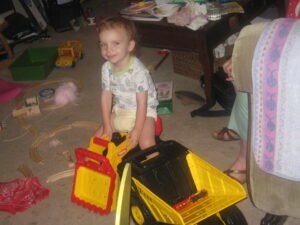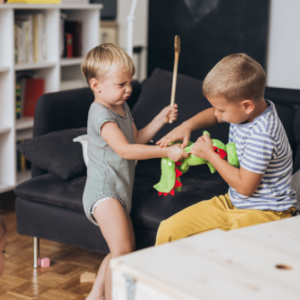In my child psychology class in college, I was taught the value of time-outs for children. It was supposed to teach the child control and discipline, resulting in a well-behaved child. So, when my children were born, I tried using time-outs to correct them.
My first child developed an obsession with the kitchen timer I used to monitor time-outs. She would do things just to get a time-out. Once I saw the problem, I gave her the timer and a whole host of discipline issues magically vanished.
My second child cared little for the timer and faced his time-outs like a mob boss in jail. He would sit there for the two minutes I assigned to him. But the moment his imprisonment was over, he ran as fast as he could to do again whatever had landed him in time-out in the first place. His respect for authority could fit into one of his tiny baby toes. He cared not. As a parent, I learned to distract, encourage, and cajole to get better behavior. I removed temptations and put up baby gates that looked straight out of Fort Knox.
Then, one day, we had a life-changing moment.
 My son got for his second birthday one of those large metal Tonka Dump Trucks that little boys everywhere love. The bed of the dump truck was metal and could lift to dump things out of it. It was so large, he could sit on it. He adored that truck.
My son got for his second birthday one of those large metal Tonka Dump Trucks that little boys everywhere love. The bed of the dump truck was metal and could lift to dump things out of it. It was so large, he could sit on it. He adored that truck.
On this fateful morning, he was playing with it when I walked in. He was drinking chocolate milk from his sippy cup and then spitting it into the truck bed. I’m not sure whether in his little boy brain, he was feeding the truck, making mud, or some combo of the two but it was making a mess on the carpet. My son was prone to play the same game and make the same mess over and over again. I knew I had to act quickly.
I walked over and scolded the truck.
“Tonka Truck, you are making a mess! Trucks that make messes like this can’t stay in the house, ” I told it. Then I picked up the truck and carried it to the backyard, dumping the milk into the grass as I went. I placed the truck where my son could see it from the window and came back in.
“Oh, no! Tonka Truck!” He exclaimed with worry in his big blue eyes.
Then, it started to rain. Not hard, but it was raining. I knew this toy was almost indestructible and could take a little rain, but my son got very upset. “Mommy, Tonka Truck is in the rain!”
I took a deep breath and didn’t crack. “Well, sweetie, Tonka Truck was very naughty so he has to have a time-out outside. Because messy toys go outside, ” I told him, pausing for a moment to look at the truck dramatically. “If I let Tonka Truck come back in the house, do you think you can teach him to be a good truck and not make messes?” I asked.
“Yes, yes.” My son said, nodding his blond head.
“Okay, you can go get him, ” I said. I let him run out into the rain, which had never really been more than a drizzle. He brought the truck back inside as fast as he could and dried him off. Tonka Truck never made another mess in the house. And I experienced a true Mom Win.
Turning Time-Out On Its Head
After that, I discovered the power of putting “bad” toys in time-out and telling my children it was their responsibility to “teach” our toys how to behave. Plastic swords and Nerf guns were the most frequent offenders as my children got older. “I’m sorry, but that toy keeps hurting your sister, so it needs to go to time-out until it can play nice.”
Toys that were repeat offenders spent longer and longer in time-out, with a few staying there for weeks at a time.
Whenever a toy came out of time-out, whether it was after a few minutes, hours, or days, I always reminded my child that they were responsible for making sure this toy was “good.” Sometimes I had to review rules, like how we can only sword fight if everyone is armed and no headshots. Sometimes the time-out alone was enough.
Ensuring the Punishment Fits the Crime
 I was always careful to set the time-out length to be appropriate to the child, the toy, and the crime. When my youngest daughter was 2, she took to using her doll as a weapon against her older brother.
I was always careful to set the time-out length to be appropriate to the child, the toy, and the crime. When my youngest daughter was 2, she took to using her doll as a weapon against her older brother.
Dolly only needed a few minutes on a high shelf to learn her lesson. “Dolly be good” my toddler promised and quickly took the doll off to her room to put her in witness protection.
On the other hand, there’s a pellet gun from when my son was 10 that’s still in time-out in my closet. It has another 10 years of hard time to do.
The Golden Rule For Toys
The single golden rule for toys at my house is: Do Not Make Mom Mad. Toys do not get lawyers or trials. Toys do their hard time and get told not to break that single rule again. I’ve found this simple, yet somehow vague rule is best for toys.
I have honestly been amazed at how well this technique has worked. If my kids fight too much over a single toy, it can go to time-out “until it knows how to play with everyone.” In that case or other more complex situations, I may ask my child to explain how they are going to keep this toy out of trouble if I return it. Letting my child think through the problem behavior and consider solutions on their own has helped them develop good problem-solving skills. By blaming the toy for the bad behavior, we’ve taken away the guilt and shame that children may feel, but that doesn’t lead to better behavior. Instead, we have found solutions.
Practicing Restraint and Problem Solving
 Impulsive children especially benefit from this form of consequence because it lets them think through what to do with a problematic situation. Some toys do create a problem, after all. Some toys are naturally messy, dangerous, or annoying. And some toys, like swords, are made to hit with. So children have to learn to control themselves to play appropriately and not hurt others. Helping the child realize that some toys are problematic can help the child remember to focus on their behavior with them, without hurting the child’s sense of self.
Impulsive children especially benefit from this form of consequence because it lets them think through what to do with a problematic situation. Some toys do create a problem, after all. Some toys are naturally messy, dangerous, or annoying. And some toys, like swords, are made to hit with. So children have to learn to control themselves to play appropriately and not hurt others. Helping the child realize that some toys are problematic can help the child remember to focus on their behavior with them, without hurting the child’s sense of self.
The other surprising thing with this technique is that it not only worked with my child who was difficult to discipline, but he learned to use this technique when dealing with other kids. When he was about 7, we had a playdate where a younger child was chasing all the other children riding their bikes in the cul-de-sac with a Nerf battle ax. My son saw that this could cause someone to get hurt and got mad.
Instead of getting into an argument with the little warrior, he took the ax, and put it on top of my minivan, in time-out. Maybe that doesn’t sound like much. But in a world where we expect little boys to hit each other when they get mad, I was thrilled my son chose a non-violent way to deal with the situation.
So, if you have toys that cause fights, make messes, or tend to hit, I suggest you try putting them in time-out. Instead of making your children feel like criminals, turn them into little parole officers who keep their toys out of trouble.





0 Comments